Understanding AASB Standards and Their Role in Economic Decision Making
VerifiedAdded on 2022/11/13
|8
|2053
|115
AI Summary
This article discusses the Australian Accounting Standards Board (AASB) and its role in developing financial standards for companies in Australia. It covers AASB standards 101, 9, 107, and 16, and explains how understanding these standards can assist users in making economic decisions. The article also discusses the benefits of complying with these standards, such as increased transparency and accountability. The subject is finance, and the document type is an essay. The course code, course name, and college/university are not mentioned.
Contribute Materials
Your contribution can guide someone’s learning journey. Share your
documents today.

FINANCE 1
Finance
Name
ID
Course
Unit
Lecturer
Date
Finance
Name
ID
Course
Unit
Lecturer
Date
Secure Best Marks with AI Grader
Need help grading? Try our AI Grader for instant feedback on your assignments.
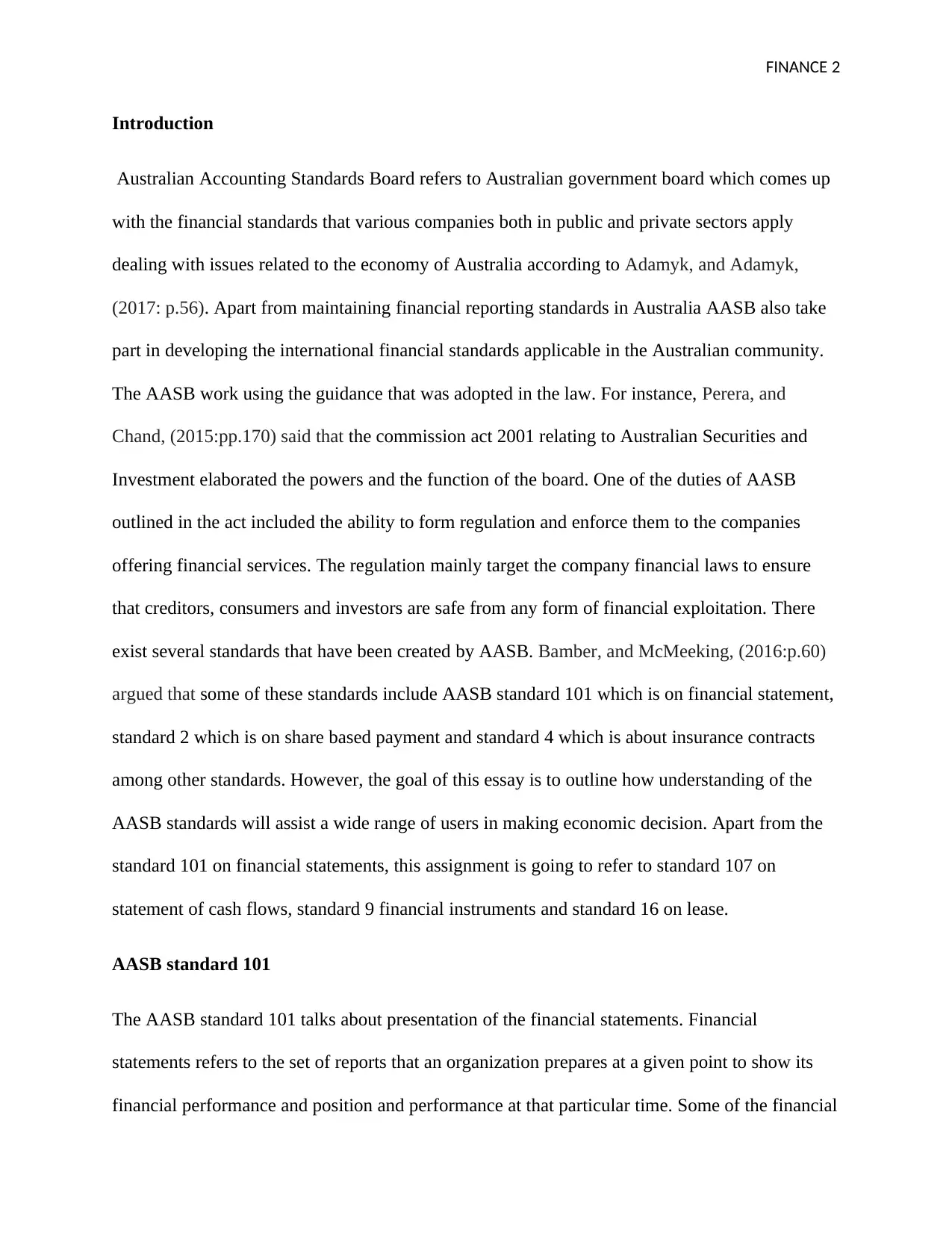
FINANCE 2
Introduction
Australian Accounting Standards Board refers to Australian government board which comes up
with the financial standards that various companies both in public and private sectors apply
dealing with issues related to the economy of Australia according to Adamyk, and Adamyk,
(2017: p.56). Apart from maintaining financial reporting standards in Australia AASB also take
part in developing the international financial standards applicable in the Australian community.
The AASB work using the guidance that was adopted in the law. For instance, Perera, and
Chand, (2015:pp.170) said that the commission act 2001 relating to Australian Securities and
Investment elaborated the powers and the function of the board. One of the duties of AASB
outlined in the act included the ability to form regulation and enforce them to the companies
offering financial services. The regulation mainly target the company financial laws to ensure
that creditors, consumers and investors are safe from any form of financial exploitation. There
exist several standards that have been created by AASB. Bamber, and McMeeking, (2016:p.60)
argued that some of these standards include AASB standard 101 which is on financial statement,
standard 2 which is on share based payment and standard 4 which is about insurance contracts
among other standards. However, the goal of this essay is to outline how understanding of the
AASB standards will assist a wide range of users in making economic decision. Apart from the
standard 101 on financial statements, this assignment is going to refer to standard 107 on
statement of cash flows, standard 9 financial instruments and standard 16 on lease.
AASB standard 101
The AASB standard 101 talks about presentation of the financial statements. Financial
statements refers to the set of reports that an organization prepares at a given point to show its
financial performance and position and performance at that particular time. Some of the financial
Introduction
Australian Accounting Standards Board refers to Australian government board which comes up
with the financial standards that various companies both in public and private sectors apply
dealing with issues related to the economy of Australia according to Adamyk, and Adamyk,
(2017: p.56). Apart from maintaining financial reporting standards in Australia AASB also take
part in developing the international financial standards applicable in the Australian community.
The AASB work using the guidance that was adopted in the law. For instance, Perera, and
Chand, (2015:pp.170) said that the commission act 2001 relating to Australian Securities and
Investment elaborated the powers and the function of the board. One of the duties of AASB
outlined in the act included the ability to form regulation and enforce them to the companies
offering financial services. The regulation mainly target the company financial laws to ensure
that creditors, consumers and investors are safe from any form of financial exploitation. There
exist several standards that have been created by AASB. Bamber, and McMeeking, (2016:p.60)
argued that some of these standards include AASB standard 101 which is on financial statement,
standard 2 which is on share based payment and standard 4 which is about insurance contracts
among other standards. However, the goal of this essay is to outline how understanding of the
AASB standards will assist a wide range of users in making economic decision. Apart from the
standard 101 on financial statements, this assignment is going to refer to standard 107 on
statement of cash flows, standard 9 financial instruments and standard 16 on lease.
AASB standard 101
The AASB standard 101 talks about presentation of the financial statements. Financial
statements refers to the set of reports that an organization prepares at a given point to show its
financial performance and position and performance at that particular time. Some of the financial
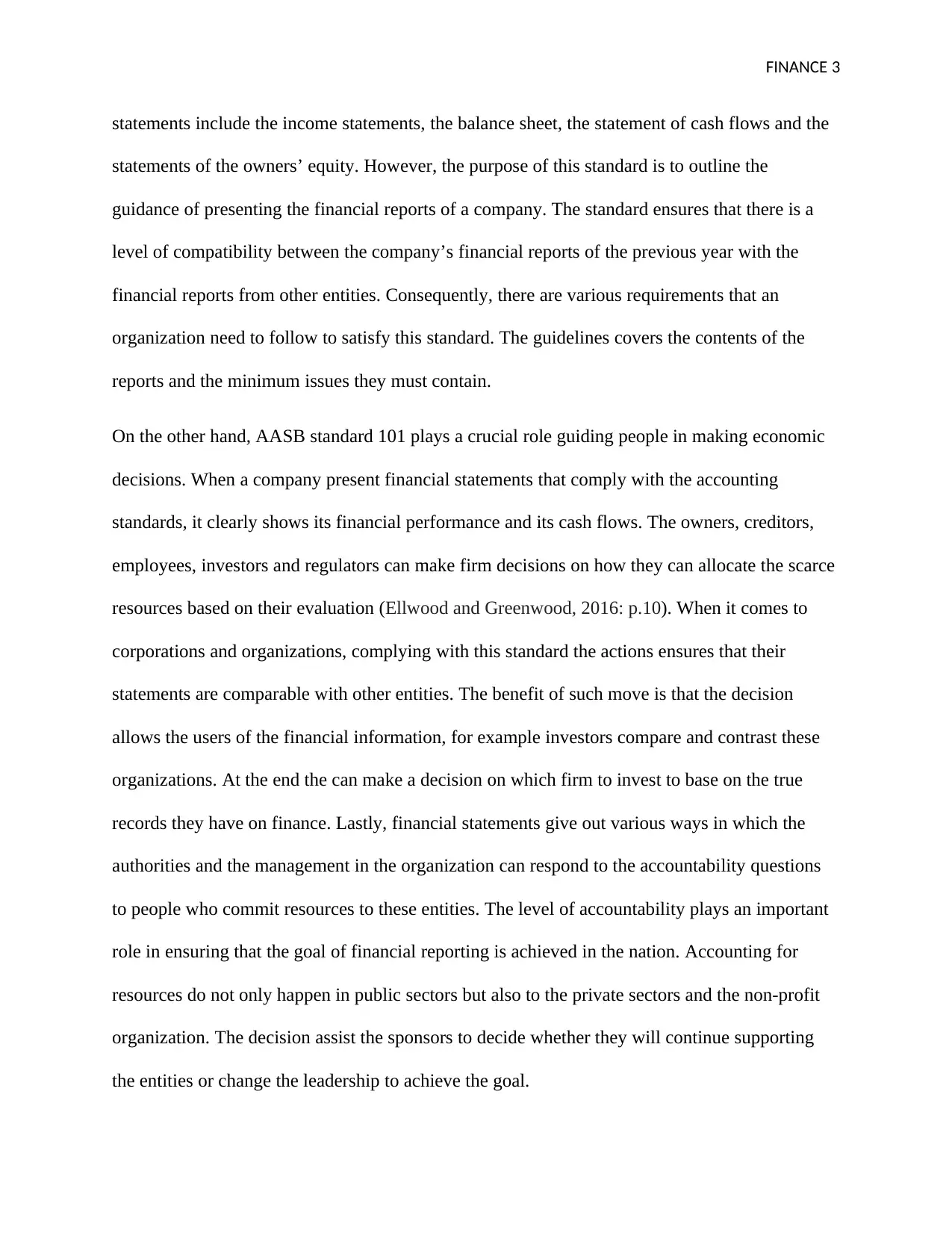
FINANCE 3
statements include the income statements, the balance sheet, the statement of cash flows and the
statements of the owners’ equity. However, the purpose of this standard is to outline the
guidance of presenting the financial reports of a company. The standard ensures that there is a
level of compatibility between the company’s financial reports of the previous year with the
financial reports from other entities. Consequently, there are various requirements that an
organization need to follow to satisfy this standard. The guidelines covers the contents of the
reports and the minimum issues they must contain.
On the other hand, AASB standard 101 plays a crucial role guiding people in making economic
decisions. When a company present financial statements that comply with the accounting
standards, it clearly shows its financial performance and its cash flows. The owners, creditors,
employees, investors and regulators can make firm decisions on how they can allocate the scarce
resources based on their evaluation (Ellwood and Greenwood, 2016: p.10). When it comes to
corporations and organizations, complying with this standard the actions ensures that their
statements are comparable with other entities. The benefit of such move is that the decision
allows the users of the financial information, for example investors compare and contrast these
organizations. At the end the can make a decision on which firm to invest to base on the true
records they have on finance. Lastly, financial statements give out various ways in which the
authorities and the management in the organization can respond to the accountability questions
to people who commit resources to these entities. The level of accountability plays an important
role in ensuring that the goal of financial reporting is achieved in the nation. Accounting for
resources do not only happen in public sectors but also to the private sectors and the non-profit
organization. The decision assist the sponsors to decide whether they will continue supporting
the entities or change the leadership to achieve the goal.
statements include the income statements, the balance sheet, the statement of cash flows and the
statements of the owners’ equity. However, the purpose of this standard is to outline the
guidance of presenting the financial reports of a company. The standard ensures that there is a
level of compatibility between the company’s financial reports of the previous year with the
financial reports from other entities. Consequently, there are various requirements that an
organization need to follow to satisfy this standard. The guidelines covers the contents of the
reports and the minimum issues they must contain.
On the other hand, AASB standard 101 plays a crucial role guiding people in making economic
decisions. When a company present financial statements that comply with the accounting
standards, it clearly shows its financial performance and its cash flows. The owners, creditors,
employees, investors and regulators can make firm decisions on how they can allocate the scarce
resources based on their evaluation (Ellwood and Greenwood, 2016: p.10). When it comes to
corporations and organizations, complying with this standard the actions ensures that their
statements are comparable with other entities. The benefit of such move is that the decision
allows the users of the financial information, for example investors compare and contrast these
organizations. At the end the can make a decision on which firm to invest to base on the true
records they have on finance. Lastly, financial statements give out various ways in which the
authorities and the management in the organization can respond to the accountability questions
to people who commit resources to these entities. The level of accountability plays an important
role in ensuring that the goal of financial reporting is achieved in the nation. Accounting for
resources do not only happen in public sectors but also to the private sectors and the non-profit
organization. The decision assist the sponsors to decide whether they will continue supporting
the entities or change the leadership to achieve the goal.
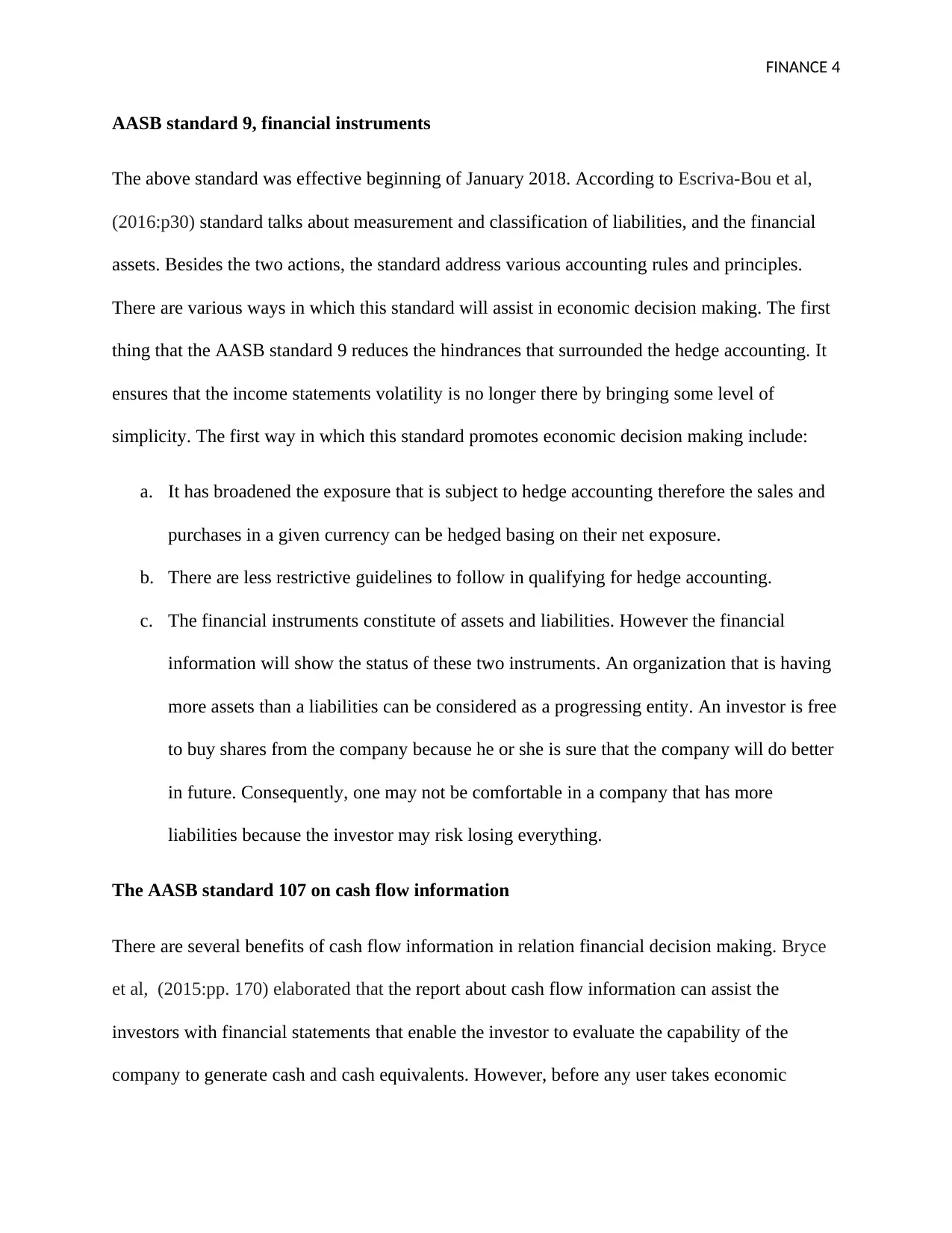
FINANCE 4
AASB standard 9, financial instruments
The above standard was effective beginning of January 2018. According to Escriva-Bou et al,
(2016:p30) standard talks about measurement and classification of liabilities, and the financial
assets. Besides the two actions, the standard address various accounting rules and principles.
There are various ways in which this standard will assist in economic decision making. The first
thing that the AASB standard 9 reduces the hindrances that surrounded the hedge accounting. It
ensures that the income statements volatility is no longer there by bringing some level of
simplicity. The first way in which this standard promotes economic decision making include:
a. It has broadened the exposure that is subject to hedge accounting therefore the sales and
purchases in a given currency can be hedged basing on their net exposure.
b. There are less restrictive guidelines to follow in qualifying for hedge accounting.
c. The financial instruments constitute of assets and liabilities. However the financial
information will show the status of these two instruments. An organization that is having
more assets than a liabilities can be considered as a progressing entity. An investor is free
to buy shares from the company because he or she is sure that the company will do better
in future. Consequently, one may not be comfortable in a company that has more
liabilities because the investor may risk losing everything.
The AASB standard 107 on cash flow information
There are several benefits of cash flow information in relation financial decision making. Bryce
et al, (2015:pp. 170) elaborated that the report about cash flow information can assist the
investors with financial statements that enable the investor to evaluate the capability of the
company to generate cash and cash equivalents. However, before any user takes economic
AASB standard 9, financial instruments
The above standard was effective beginning of January 2018. According to Escriva-Bou et al,
(2016:p30) standard talks about measurement and classification of liabilities, and the financial
assets. Besides the two actions, the standard address various accounting rules and principles.
There are various ways in which this standard will assist in economic decision making. The first
thing that the AASB standard 9 reduces the hindrances that surrounded the hedge accounting. It
ensures that the income statements volatility is no longer there by bringing some level of
simplicity. The first way in which this standard promotes economic decision making include:
a. It has broadened the exposure that is subject to hedge accounting therefore the sales and
purchases in a given currency can be hedged basing on their net exposure.
b. There are less restrictive guidelines to follow in qualifying for hedge accounting.
c. The financial instruments constitute of assets and liabilities. However the financial
information will show the status of these two instruments. An organization that is having
more assets than a liabilities can be considered as a progressing entity. An investor is free
to buy shares from the company because he or she is sure that the company will do better
in future. Consequently, one may not be comfortable in a company that has more
liabilities because the investor may risk losing everything.
The AASB standard 107 on cash flow information
There are several benefits of cash flow information in relation financial decision making. Bryce
et al, (2015:pp. 170) elaborated that the report about cash flow information can assist the
investors with financial statements that enable the investor to evaluate the capability of the
company to generate cash and cash equivalents. However, before any user takes economic
Secure Best Marks with AI Grader
Need help grading? Try our AI Grader for instant feedback on your assignments.
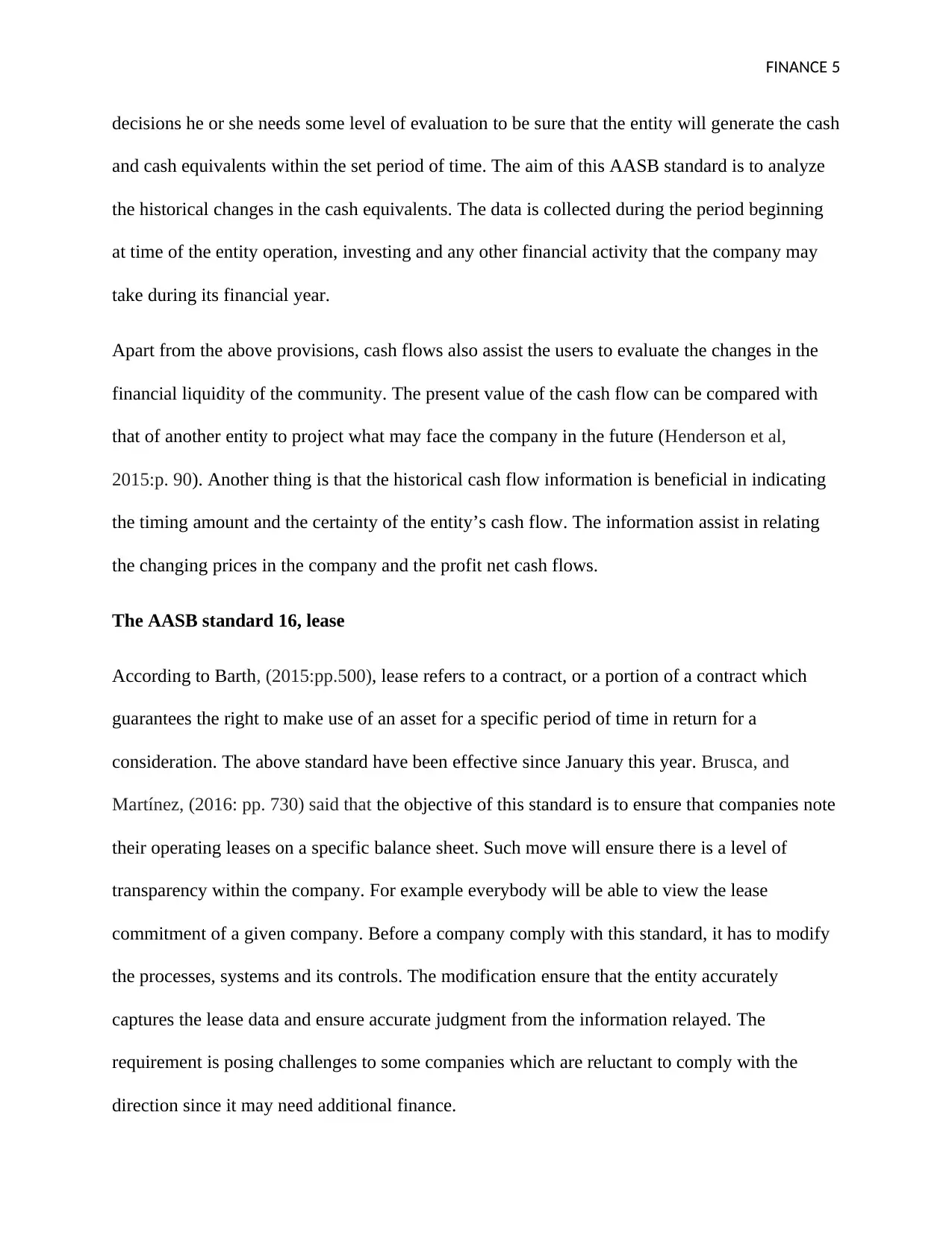
FINANCE 5
decisions he or she needs some level of evaluation to be sure that the entity will generate the cash
and cash equivalents within the set period of time. The aim of this AASB standard is to analyze
the historical changes in the cash equivalents. The data is collected during the period beginning
at time of the entity operation, investing and any other financial activity that the company may
take during its financial year.
Apart from the above provisions, cash flows also assist the users to evaluate the changes in the
financial liquidity of the community. The present value of the cash flow can be compared with
that of another entity to project what may face the company in the future (Henderson et al,
2015:p. 90). Another thing is that the historical cash flow information is beneficial in indicating
the timing amount and the certainty of the entity’s cash flow. The information assist in relating
the changing prices in the company and the profit net cash flows.
The AASB standard 16, lease
According to Barth, (2015:pp.500), lease refers to a contract, or a portion of a contract which
guarantees the right to make use of an asset for a specific period of time in return for a
consideration. The above standard have been effective since January this year. Brusca, and
Martínez, (2016: pp. 730) said that the objective of this standard is to ensure that companies note
their operating leases on a specific balance sheet. Such move will ensure there is a level of
transparency within the company. For example everybody will be able to view the lease
commitment of a given company. Before a company comply with this standard, it has to modify
the processes, systems and its controls. The modification ensure that the entity accurately
captures the lease data and ensure accurate judgment from the information relayed. The
requirement is posing challenges to some companies which are reluctant to comply with the
direction since it may need additional finance.
decisions he or she needs some level of evaluation to be sure that the entity will generate the cash
and cash equivalents within the set period of time. The aim of this AASB standard is to analyze
the historical changes in the cash equivalents. The data is collected during the period beginning
at time of the entity operation, investing and any other financial activity that the company may
take during its financial year.
Apart from the above provisions, cash flows also assist the users to evaluate the changes in the
financial liquidity of the community. The present value of the cash flow can be compared with
that of another entity to project what may face the company in the future (Henderson et al,
2015:p. 90). Another thing is that the historical cash flow information is beneficial in indicating
the timing amount and the certainty of the entity’s cash flow. The information assist in relating
the changing prices in the company and the profit net cash flows.
The AASB standard 16, lease
According to Barth, (2015:pp.500), lease refers to a contract, or a portion of a contract which
guarantees the right to make use of an asset for a specific period of time in return for a
consideration. The above standard have been effective since January this year. Brusca, and
Martínez, (2016: pp. 730) said that the objective of this standard is to ensure that companies note
their operating leases on a specific balance sheet. Such move will ensure there is a level of
transparency within the company. For example everybody will be able to view the lease
commitment of a given company. Before a company comply with this standard, it has to modify
the processes, systems and its controls. The modification ensure that the entity accurately
captures the lease data and ensure accurate judgment from the information relayed. The
requirement is posing challenges to some companies which are reluctant to comply with the
direction since it may need additional finance.
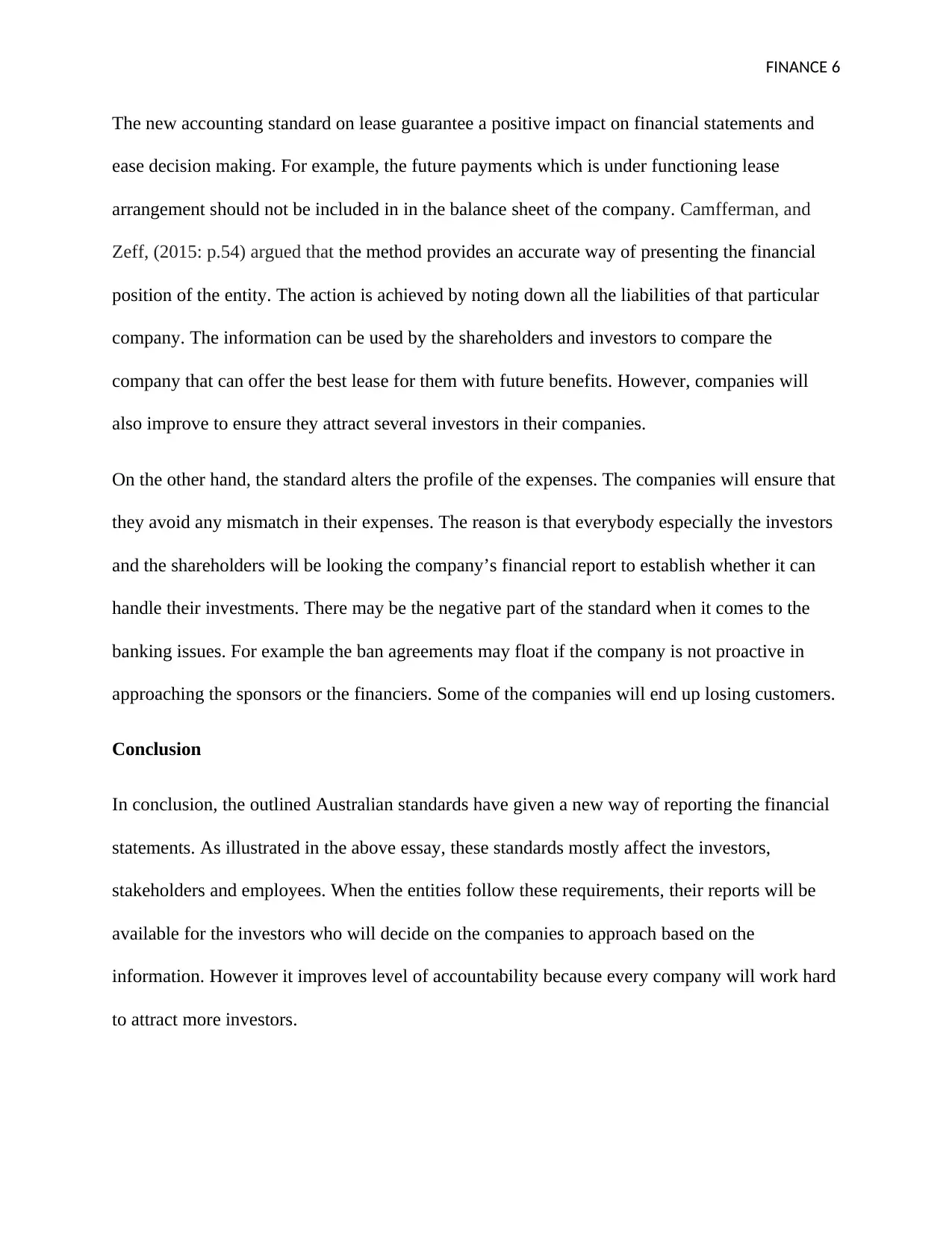
FINANCE 6
The new accounting standard on lease guarantee a positive impact on financial statements and
ease decision making. For example, the future payments which is under functioning lease
arrangement should not be included in in the balance sheet of the company. Camfferman, and
Zeff, (2015: p.54) argued that the method provides an accurate way of presenting the financial
position of the entity. The action is achieved by noting down all the liabilities of that particular
company. The information can be used by the shareholders and investors to compare the
company that can offer the best lease for them with future benefits. However, companies will
also improve to ensure they attract several investors in their companies.
On the other hand, the standard alters the profile of the expenses. The companies will ensure that
they avoid any mismatch in their expenses. The reason is that everybody especially the investors
and the shareholders will be looking the company’s financial report to establish whether it can
handle their investments. There may be the negative part of the standard when it comes to the
banking issues. For example the ban agreements may float if the company is not proactive in
approaching the sponsors or the financiers. Some of the companies will end up losing customers.
Conclusion
In conclusion, the outlined Australian standards have given a new way of reporting the financial
statements. As illustrated in the above essay, these standards mostly affect the investors,
stakeholders and employees. When the entities follow these requirements, their reports will be
available for the investors who will decide on the companies to approach based on the
information. However it improves level of accountability because every company will work hard
to attract more investors.
The new accounting standard on lease guarantee a positive impact on financial statements and
ease decision making. For example, the future payments which is under functioning lease
arrangement should not be included in in the balance sheet of the company. Camfferman, and
Zeff, (2015: p.54) argued that the method provides an accurate way of presenting the financial
position of the entity. The action is achieved by noting down all the liabilities of that particular
company. The information can be used by the shareholders and investors to compare the
company that can offer the best lease for them with future benefits. However, companies will
also improve to ensure they attract several investors in their companies.
On the other hand, the standard alters the profile of the expenses. The companies will ensure that
they avoid any mismatch in their expenses. The reason is that everybody especially the investors
and the shareholders will be looking the company’s financial report to establish whether it can
handle their investments. There may be the negative part of the standard when it comes to the
banking issues. For example the ban agreements may float if the company is not proactive in
approaching the sponsors or the financiers. Some of the companies will end up losing customers.
Conclusion
In conclusion, the outlined Australian standards have given a new way of reporting the financial
statements. As illustrated in the above essay, these standards mostly affect the investors,
stakeholders and employees. When the entities follow these requirements, their reports will be
available for the investors who will decide on the companies to approach based on the
information. However it improves level of accountability because every company will work hard
to attract more investors.
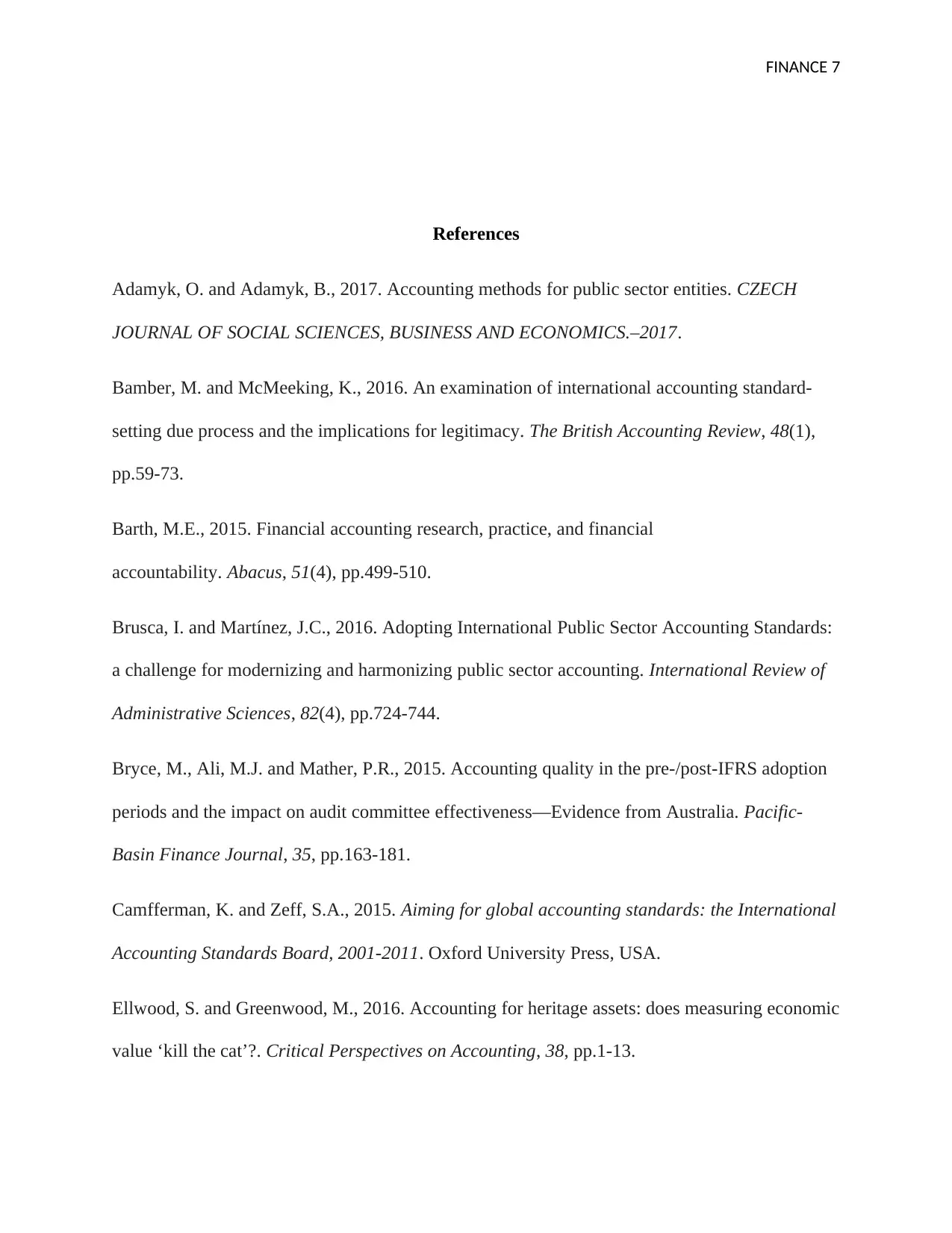
FINANCE 7
References
Adamyk, O. and Adamyk, B., 2017. Accounting methods for public sector entities. CZECH
JOURNAL OF SOCIAL SCIENCES, BUSINESS AND ECONOMICS.–2017.
Bamber, M. and McMeeking, K., 2016. An examination of international accounting standard-
setting due process and the implications for legitimacy. The British Accounting Review, 48(1),
pp.59-73.
Barth, M.E., 2015. Financial accounting research, practice, and financial
accountability. Abacus, 51(4), pp.499-510.
Brusca, I. and Martínez, J.C., 2016. Adopting International Public Sector Accounting Standards:
a challenge for modernizing and harmonizing public sector accounting. International Review of
Administrative Sciences, 82(4), pp.724-744.
Bryce, M., Ali, M.J. and Mather, P.R., 2015. Accounting quality in the pre-/post-IFRS adoption
periods and the impact on audit committee effectiveness—Evidence from Australia. Pacific-
Basin Finance Journal, 35, pp.163-181.
Camfferman, K. and Zeff, S.A., 2015. Aiming for global accounting standards: the International
Accounting Standards Board, 2001-2011. Oxford University Press, USA.
Ellwood, S. and Greenwood, M., 2016. Accounting for heritage assets: does measuring economic
value ‘kill the cat’?. Critical Perspectives on Accounting, 38, pp.1-13.
References
Adamyk, O. and Adamyk, B., 2017. Accounting methods for public sector entities. CZECH
JOURNAL OF SOCIAL SCIENCES, BUSINESS AND ECONOMICS.–2017.
Bamber, M. and McMeeking, K., 2016. An examination of international accounting standard-
setting due process and the implications for legitimacy. The British Accounting Review, 48(1),
pp.59-73.
Barth, M.E., 2015. Financial accounting research, practice, and financial
accountability. Abacus, 51(4), pp.499-510.
Brusca, I. and Martínez, J.C., 2016. Adopting International Public Sector Accounting Standards:
a challenge for modernizing and harmonizing public sector accounting. International Review of
Administrative Sciences, 82(4), pp.724-744.
Bryce, M., Ali, M.J. and Mather, P.R., 2015. Accounting quality in the pre-/post-IFRS adoption
periods and the impact on audit committee effectiveness—Evidence from Australia. Pacific-
Basin Finance Journal, 35, pp.163-181.
Camfferman, K. and Zeff, S.A., 2015. Aiming for global accounting standards: the International
Accounting Standards Board, 2001-2011. Oxford University Press, USA.
Ellwood, S. and Greenwood, M., 2016. Accounting for heritage assets: does measuring economic
value ‘kill the cat’?. Critical Perspectives on Accounting, 38, pp.1-13.
Paraphrase This Document
Need a fresh take? Get an instant paraphrase of this document with our AI Paraphraser
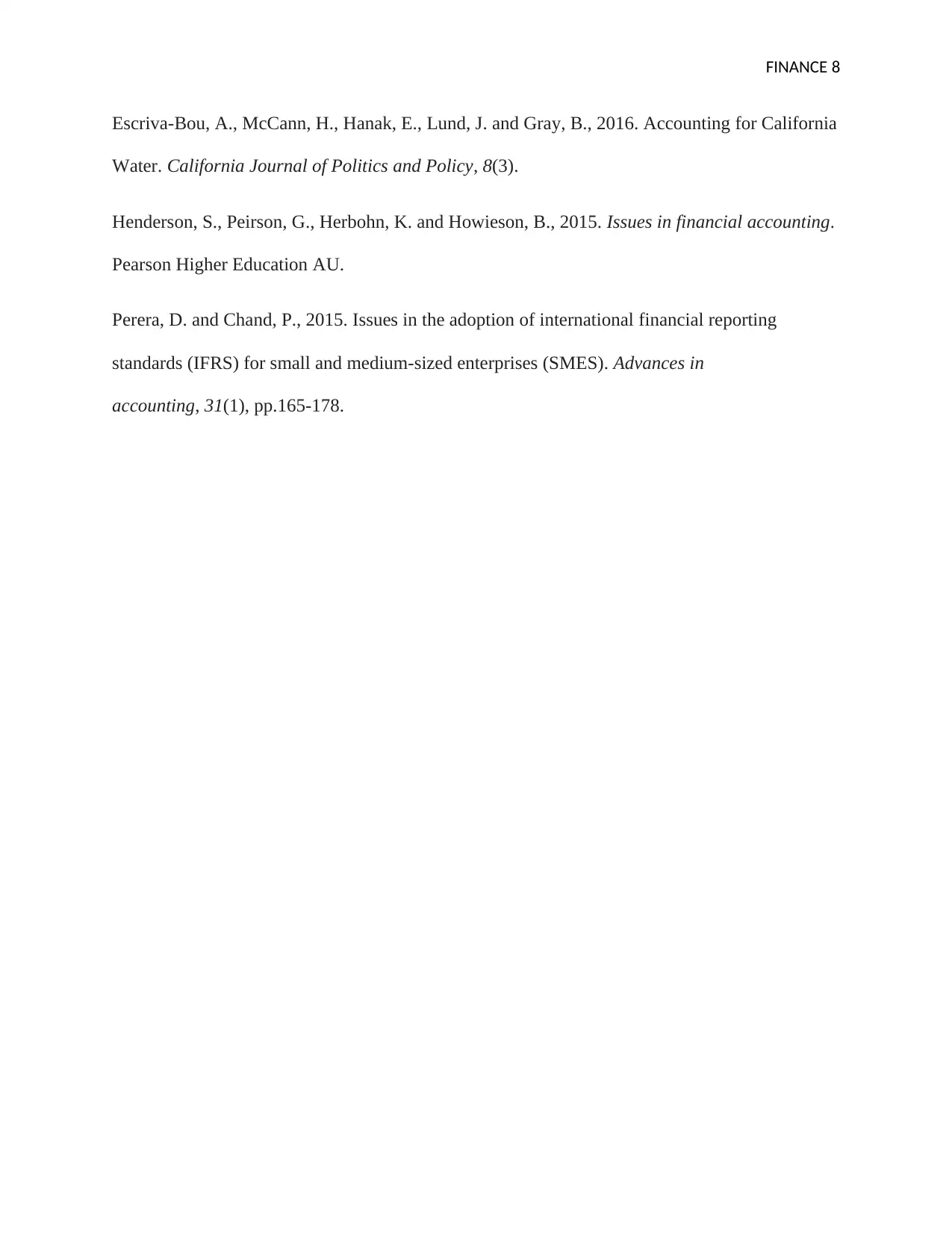
FINANCE 8
Escriva-Bou, A., McCann, H., Hanak, E., Lund, J. and Gray, B., 2016. Accounting for California
Water. California Journal of Politics and Policy, 8(3).
Henderson, S., Peirson, G., Herbohn, K. and Howieson, B., 2015. Issues in financial accounting.
Pearson Higher Education AU.
Perera, D. and Chand, P., 2015. Issues in the adoption of international financial reporting
standards (IFRS) for small and medium-sized enterprises (SMES). Advances in
accounting, 31(1), pp.165-178.
Escriva-Bou, A., McCann, H., Hanak, E., Lund, J. and Gray, B., 2016. Accounting for California
Water. California Journal of Politics and Policy, 8(3).
Henderson, S., Peirson, G., Herbohn, K. and Howieson, B., 2015. Issues in financial accounting.
Pearson Higher Education AU.
Perera, D. and Chand, P., 2015. Issues in the adoption of international financial reporting
standards (IFRS) for small and medium-sized enterprises (SMES). Advances in
accounting, 31(1), pp.165-178.
1 out of 8
Related Documents
Your All-in-One AI-Powered Toolkit for Academic Success.
+13062052269
info@desklib.com
Available 24*7 on WhatsApp / Email
![[object Object]](/_next/static/media/star-bottom.7253800d.svg)
Unlock your academic potential
© 2024 | Zucol Services PVT LTD | All rights reserved.





